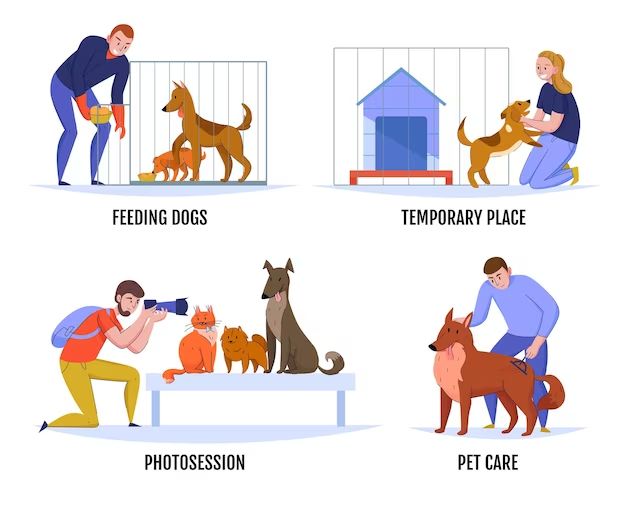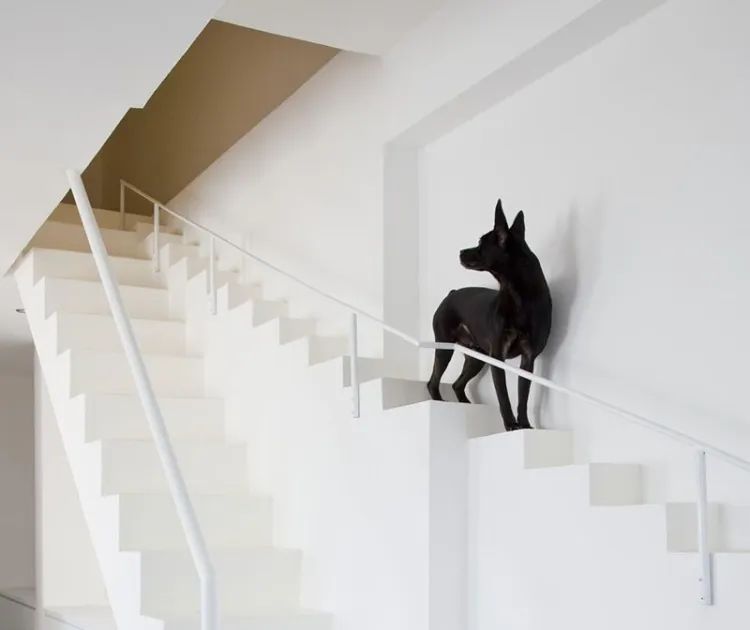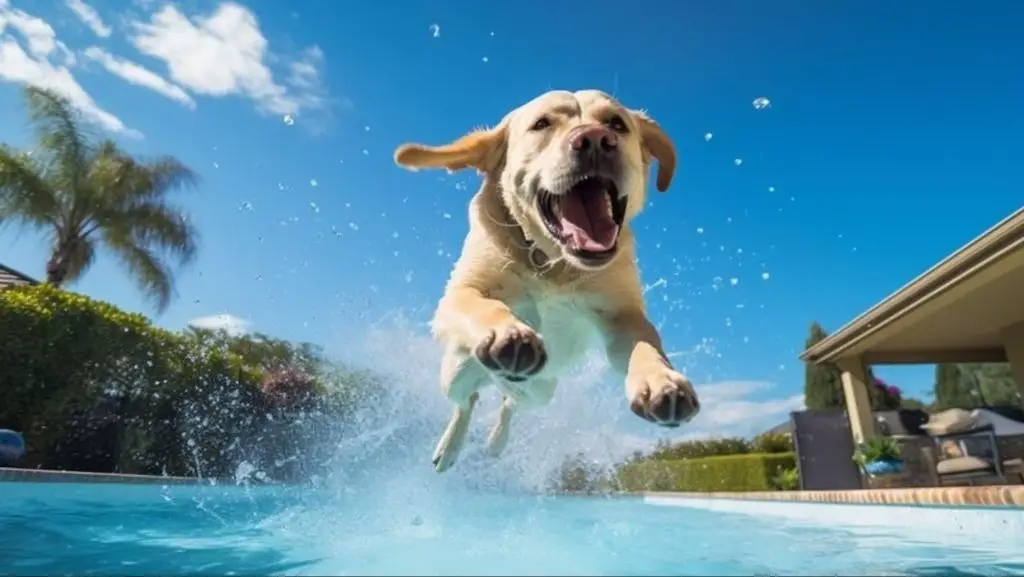Introduction
Dogs and stairs have had a long shared history ever since humans started building multi-level structures. Stairs allow our canine companions to access different floors and parts of our homes. Some dogs eagerly bound up and down stairs with energy and excitement, while others are more hesitant and cautious on steps.
This article explores the world of dogs and stairs – from energetic puppies leaping down steps to helpful tips for training dogs on stairs safely. We’ll look at interesting facts about breeds that love stairs, proper stair design for dogs, and the benefits of using stairs for canine health and agility.
Learning about dogs on stairs can help owners better understand their pet’s behaviors and abilities. Proper training on stairs is also important to help avoid injuries. By grasping key information about dogs and stairs, owners can support their canine companion’s navigation of steps and staircase structures.
Common Breeds That Jump Down Stairs

Certain breeds of dogs are more prone to jumping down stairs than others. High energy and athletic breeds often enjoy leaping down staircases. Some common breeds known for stair jumping include:
Labrador Retrievers – Labradors are energetic, playful dogs originally bred for retrieving downed fowl. Their energetic nature and strong hind legs make them natural stair jumpers.
Border Collies – These highly intelligent herding dogs love to run and jump. Border collies will eagerly bound down stairs when excited. Their agility makes them stellar stair jumpers.
Jack Russell Terriers – Feisty and lively Jack Russells jump down stairs with abandon. These compact terriers have strong legs that allow them to fearlessly take flying leaps down flights of stairs.
Australian Shepherds – Aussies were bred to nimbly hop around sheep. Their athleticism translates well to descending stairs rapidly. Aussies joyfully bound down stairs two to three steps at a time.
Golden Retrievers – Happy-go-lucky Goldens will eagerly chase toys or people down staircases. Their muscular hind legs enable Goldens to safely launch themselves down stairs.
High energy breeds like Collies, Shelties, Poodles, and Schnauzers are also quite adept at jumping down stairs. These breeds have muscular rear legs and energetic temperaments perfect for stair leaping. With training and supervision, stair jumping can be a fun outlet for active dogs.
Training Tips
Dogs naturally love leaping down stairs, but this behavior can be dangerous and unwanted. Instead of punishing your dog for jumping, try these positive training methods.
Discourage jumping by blocking access to the stairs with a baby gate. Only allow your dog on the stairs when supervised. When they try to jump, say “no” firmly and redirect their energy with a treat or toy. Praise them for having all four paws on a single step.
Teach an alternative behavior like sitting patiently before being invited to walk down the stairs calmly. Reward your dog with treats for waiting instead of jumping. You can also teach them to climb stairs one at a time on a leash, rewarding each deliberate step.
Always use positive reinforcement like treats, praise and play. Never punish your dog for stair jumping, as this can create fear and anxiety. Stay patient, as it may take many repetitions for your dog to unlearn this habit.
With persistence and positivity, you can curb your dog’s stair diving in a healthy, humane way. They’ll be safer and you’ll avoid frustration through force-free training methods.
Safety Concerns
Dogs jumping down stairs can potentially lead to injuries if proper precautions are not taken. Some of the most common injuries include:

- Sprains and strains – Jumping downstairs puts extra stress on joints and can lead to sprains and strains, especially in the legs and paws.
- Slipped discs – The impact of jumping down stairs may cause intervertebral discs to rupture or herniate.
- Fractures – Dogs can fracture bones if they land awkwardly after jumping from too high up.
- Abrasions and lacerations – Scrapes and cuts can occur if dogs slip and slide across the stairs or edges.
There are several ways to prevent injuries from dogs jumping downstairs:
- Install carpeted runners or non-slip surfaces on stairs.
- Restrict access to stairs using baby gates.
- Teach dogs to use the stairs appropriately and avoid excessive jumping.
- Provide ramps or steps as an alternative.
- Make sure stairs are not too steep or have uneven steps.
Signs that your dog may have an injury from jumping downstairs include:
- Limping or holding up a leg.
- Yelping in pain when using the stairs.
- Reluctance to jump up or down stairs.
- Obvious signs of cuts, scrapes or swelling.
- Hunched posture or inability to straighten the back.
If you notice any of these signs, consult your veterinarian to identify and properly treat any injuries.
Proper Stair Design

When designing stairs for homes with dogs that like to jump down them, there are a few key factors to consider for safety and accessibility. The ideal stair height and depth will depend on the size of the dog, but generally between 6-7 inches in height and 11-14 inches in depth is recommended. Using carpeting or grip tape on stairs can help provide traction for dogs’ paws when landing from a jump. Opting for materials like timber or composite wood rather than slippery materials like marble or metal is also advisable. Proper lighting is crucial so dogs can see the stairs clearly when making a jump. Installing stair lighting and avoiding high-gloss finishes that could cause glare is recommended.
Fun Jump Videos
Some of the most fun videos on the internet feature dogs jumping down stairs. There’s something very entertaining about watching dogs leap down staircases with enthusiasm and grace. These cute and funny clips are worth watching.
Many show dogs displaying their athleticism with great jumps down full flights of stairs. They’ll often take the stairs two or three at a time, bounding down with their legs outstretched. Some will even turn back when they reach the bottom to prance back up and do it again.
Other videos capture the bloopers, with dogs miscalculating a jump and tumbling down some of the steps. But they quickly bounce back up, unharmed and ready to try again. Their eagerness and persistence is admirable.
All kinds of dogs love descending the stairs, from tiny Chihuahuas to giant Great Danes. Their joy and excitement is on full display. The videos celebrate dogs and stairs in a fun and uplifting way.
Jumping Championships
Jumping competitions for dogs have become increasingly popular in recent years. These exciting events showcase dogs’ incredible agility and athleticism as they leap over obstacles and navigate tricky jumping courses.
The foremost international competition is the Purina Pro Plan Incredible Dog Challenge, held annually in venues across the United States. Dogs compete in events like Big Air, a long jump competition to see who can leap the farthest. Other top championships include the Skyhoundz World Canine Disc Competition and DockDogs dock jumping contests.
To reach championship levels, dogs require extensive training to build muscles and perfect their jumping technique. Handlers use high platforms and gradually increase jump heights during training. Dogs that excel often start conditioning as puppies. Common training aids include angled platforms to launch from and targets to jump up to. Treats and toys provide motivation to leap farther.
The top dogs can make astonishing jumps of over 30 feet in Big Air competitions. Crowds are amazed by their athletic prowess. While championship events provide entertainment, they also showcase the incredible abilities that dogs can achieve with proper training and conditioning.
Working Dogs
Some dogs are bred and trained to jump as part of their working duties. There are certain jobs that require dogs to safely jump down stairs or from high perches.
Search and rescue dogs often need to jump and climb while searching disaster areas. The ability to leap down from rubble piles or jump over obstacles quickly is essential for these dogs to find people in distress. Their jumping skills combined with their keen sense of smell and hearing make search dogs invaluable for locating missing persons.
Police dogs and military working dogs also utilize jumping in their duties. K9 police dogs may have to jump fences or stairs while chasing suspects or entering buildings. Tactical military working dogs are trained to rappel down walls, leap into vehicles, and jump through windows when confronting threats. Having dogs that can jump and climb nimbly is vital for law enforcement and military operations.
Service dogs who assist people with disabilities may also need to safely jump down stairs. Guide dogs for the blind and assistance dogs for wheelchair users are often taught to properly descend stairs to avoid falls and injuries. Their jumping ability provides greater independence and mobility for their handlers.
Health Benefits of Dogs Jumping Down Stairs
Jumping up and down stairs provides numerous health benefits for dogs by giving them important daily exercise. The impact from jumping and landing helps strengthen their muscles, joints, and bones. Going up and down stairs is also a cardiovascular workout that gets a dog’s heart pumping.

Stair jumping serves as a form of weight-bearing exercise that builds muscle tone and joint stability, especially in the legs and core. The controlled landing required for going down stairs helps improve proprioception and balance. Building strength in the limbs and coordinated movement reduces the chances of injury.
In addition, briskly climbing or jumping stairs elevates a dog’s heart rate, increasing blood circulation and lung capacity. This aerobic activity supports cardiovascular health. Dogs that regularly use the stairs tend to have better stamina and energery levels.
Overall, incorporating the stairs into a dog’s daily routine, along with other exercise like walking and playing, provides important physical stimulation to keep them fit and healthy.
Conclusion
In summary, dogs jumping down stairs can be fun and rewarding for both pet and owner, but needs to be approached carefully. Proper training and safety measures are essential to prevent injury. The breed, age, and health of the dog should be considered when allowing stair jumping. With patience and the right techniques, most dogs can learn to go up and down stairs in a controlled manner. Stair design and configuration also plays a role in safety.
While exuberant stair jumping looks cute in videos, owners must temper this with wisdom. Setting up gates, teaching commands like “wait” and “slow,” and never forcing a dog can go a long way. Jumping should be an optional, trained behavior, not a requirement. With care and common sense, both owner and dog can feel satisfied with stair navigation abilities.
In the end, stairs should present minimal risk and maximum fun for canine companions. With the proper foundation, dogs can jump down stairs safely for years of happiness.
